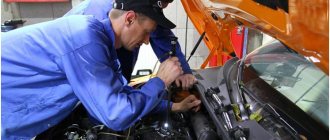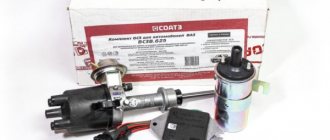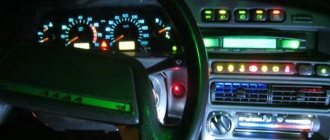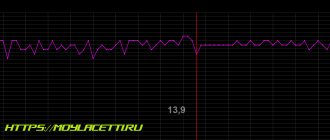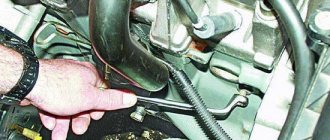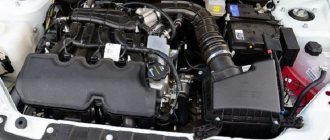- home
- car battery
- …
This problem can manifest itself both in winter (cold) and summer (warm) periods of time, and it practically does not depend in any way on winter starts. What happens when starting or when the engine is already running, one of the battery terminals begins to heat up wildly, if you drop water on it, it will begin to steam. Why does this happen and how to deal with it, let's figure it out...
At the very beginning, I want to say that this malfunction can occur on different cars (the make and model does not matter), and often this can be the reason for the battery failure, and in a very short period of time.
Why does the battery fail?
Just a couple of lines about why the battery may fail:
- Warming up the terminal, and then heating the current output and after the entire battery (including plate packs), provokes the evaporation of distilled water from the electrolyte. As the capacity drops, the plates may crumble and in general, the battery will not last long in this mode.
- If the current lead heats up, it can melt the plastic of the housing that is located next to it. Microcracks appear, through which water from the electrolyte begins to evaporate, and sulfuric acid often gets onto the terminal. Strong “oxides” form on it, which further interfere with the operation of the battery, undercharging and poor starting are possible
- YES, and the most common reason is that the case can melt from high temperatures. This is rare, but it happens; you can no longer use such a power source.
BUT this is not the only danger; a fire is not far away.
Why does the terminal get hot?
Quite large currents flow from the battery to the starter, and then from the generator back to the battery. Just think - starting currents, in winter, can reach up to 600A. If you install a thin wire, it will simply not be able to cope with such a load and will melt before your eyes. This is why the wires are so thick and solid, all because they are designed to carry high loads.
Let's watch a short video.
There are not many reasons and they are all banal:
- The problem is in the terminal itself . There is poor contact between the wire and the fastener, sometimes it comes straight from the factory, a manufacturing defect (for example, the hole in the terminal is 10 mm, and the wire is 8 mm).
- It happens over time that water can get into this place or oxides can form. The bottom line is that wires and fasteners are often made of different metals, the potential difference sooner or later leads to oxidation of the contact point and the current conductivity drops significantly.
- Oxides between the terminal and the current terminal. This also happens, but rarely, if the contact is bad, then the current must pass through a very narrow point of contact. Warming up can come from here.
- The wire . Sometimes the wire itself suffers, say, from an accidental break in the middle that is not visible to the eye. That is, several threads were broken, and the load that he could bear decreased.
- Poor contact with body . Often it is the negative cable and after the terminal that get hot. This is because it is bolted to the car body, and then both the starter and the generator are “powered” from the body. On modern foreign cars, the negative cable is quite short (on some cars it is attached to the engine block). So, the cable will heat up, but you will mistakenly think that it is the terminal (although with such a malfunction, the braiding of the wire itself will most likely begin to recover).
The positive terminal can only heat up from poor contact or, again, from oxides that have formed between the mount and the current terminal.
Boiling on the car
It is completely unacceptable if the battery boils while driving a car. This can lead to a fire; intense boiling of the electrolyte splashes it onto the car body, and it will then rapidly rust. Do not drive with a boiling battery - the battery may explode. Therefore, it is worth immediately identifying the causes and eliminating them.
Plate failure
The first thing that comes to mind is a faulty battery. Even if it is completely new, a manufacturing defect cannot be ruled out. The plates inside the battery may touch each other due to the battery freezing in winter - the electrolyte of a discharged battery contains little acid. When water freezes, it deforms the plates.
Over time, the lead plates wear out, and sediment that falls to the bottom of the jars shorts out the plates.
A failed bank causes a voltage drop at the battery terminals, and the standard generator current becomes unnecessary. The remaining banks undergo a recharging process.
In maintenance-free batteries, you can unscrew the caps and compare the boiling in the jars. If there is no boiling in one, then the battery can be scrapped.
You can also measure the voltage on a charged battery and the density in the banks. If the voltage is significantly lower than 12 volts and the density is uneven, the battery is most likely faulty.
Strong discharge
If you start a car using the “lighting” method with the battery installed, a strong electric current flows from the generator to it. The process of releasing electrons from sulfuric acid cannot proceed so intensely, and part of the energy is spent on decomposition of water and heating.
A heavily discharged battery (if the voltage is below 9 volts) should be charged with low currents in stationary conditions; it is advisable to use high-tech automatic chargers.
Fast charging from a car generator can damage the diode bridge and the generator relay regulator, as the load increases sharply.
Recharge during operation
The higher the vehicle speed, the more current the alternator can produce. The relay regulator is designed to limit the voltage corridor. This small semiconductor device prevents the vehicle current from exceeding the permissible parameters, which for most passenger cars is 14.5 volts.
If the relay regulator fails, the battery is recharged. Excess current decomposes water, vapor comes out, and electrolyte splashes out. The level drops and the plates are destroyed.
Diagnosing the relay regulator is simple - just measure the voltage of the on-board network. If it exceeds 14.6 volts (there are exceptions), then the movement must be stopped and the “chocolate bar” replaced - this is what the relay is called in the language of car mechanics.
Incorrect installation when batteries are paired
Some commercial vehicles and buses have two batteries installed to make starting easier. Owners of such cars know that two batteries need to be changed at once, otherwise the new one will quickly fail, and the old one will “drain” it while parked.
Boiling of a more powerful battery in such systems is a common occurrence, so you should install either one battery of increased capacity, or two of the same characteristics.
This is interesting: Detailed review of the IMax B6 mini charger
I give a load - it overheats
This may often be the case. You start the car, everything seems to be fine, but after you turn on the load, say heated seats, mirrors, windshield, etc., the terminal starts to heat up! Why?
And here everything is simple and the reasons that I described above work. The thing is that the generator alone may not be able to cope with such a load (especially when the headlights, radio, and instrument lighting are working); its power is limited . Therefore, part of the energy is taken from the battery, and if your contact is bad, or there are oxides, this place will heat up.
A little school physics (in simple words)
What physical quantities, from which one can start in search of understanding, are “spinning” in the heating terminal of the battery? There are several of them:
- U – voltage at the terminal.
- I is the current strength passing through the terminal (conductor).
- R – conductor resistance.
- S – cross-sectional area of the conductor.
- t – time.
- Q is the amount of heat dissipated on the conductor.
Let's start with an analysis of the most common error when operating with these quantities and the physical laws by which they are related. It is based on the fact that the terminal heats up due to poor contact, as well as on Ohm's law for a section of the circuit.
The logic is this. The worse the contact, the smaller the cross-sectional area of the conductor S. And the smaller the cross-section, the greater its resistance. Next, we take the above-mentioned Ohm's law:
And this is where the problems begin. The voltage in the car's bot network is always the same, and is approximately 12 V. Almost everyone (many on a subconscious level) understands that the greater the current, the greater the heating. And it is true. But what happens when contact deteriorates? That's right - the resistance R increases. It turns out that the worse the contact, the less current in the circuit should be. How, then, can the terminal heat up due to poor contact? The current is decreasing! It should be the other way around: the contact deteriorates, the resistance increases, the current drops - the heating decreases.
But in practice this does not work, since more than half of the reasons why battery terminals heat up are caused precisely by poor contact. But the catch is that this Ohm’s law cannot be applied to solve this problem. It’s not for nothing that it’s for a section of the chain. And we are far from a site.
But in the car, in addition to the heating terminal, there are also current consumers - a starter, a stove, an acoustic system, etc. All this also affects the strength of the current flowing through the terminal. But in practice, large currents also flow through poor contacts. And despite the fact that the resistance there has increased, the current strength does not decrease proportionately.
The current still flows. And his strength is great. This can be judged by the fact that the same starter works even with poor contacts. Accordingly, even through a bad contact, a current of more than 100 A flows. That is why Ohm’s law, no matter how cool it is, is not suitable for solving our problem, and the above algorithm will be initially erroneous.
And the correct algorithm will be like this. Since the battery terminal heats up, we are primarily interested in the Q value. It is clear that the larger it is, the stronger the overheating. Let's try to figure out what this Q depends on in the case of a heating terminal. For this, there is a simple formula from a school textbook, which is used to express the Joule-Lenz law:
What does this formula give us? Everything is extremely simple and clear. It tells us that the battery terminal can heat up for several reasons - due to current, resistance or time. The larger these values are, the stronger the heating. Accordingly, in these directions it is worth looking for a possible reason why the battery terminal is heating up.
What to do?
Everything is banal and simple, there are only a few points:
- All oxides must be cleaned. If they repeatedly appear on the surface of the battery, say on one side or the other, you need to look at it for leaks.
- Check the wire for breakdowns and breaks - if there are any, then it is better to replace the wire.
- You need to look at the point of contact between the cable and the terminal. Often this is where the issue lies. If it is negative, you can easily remove it and check it at home. Sometimes it’s easier to cut the cable from the terminal, buy a new one (now they sell improved copper or brass ones for audio equipment, by the way, they have a good fastening, with bolts) and then install it on your car
As a rule, all problems go away immediately. If you don’t do anything, then at a minimum your battery will fail (you won’t start your car), at a maximum and it’s not far from a fire; the wire braid may melt and short out. SO IT IS SURE TO ELIMINATE!
I’ll end with this, I think it was useful, read our AUTOBLOG, subscribe to the YOUTUBE channel.
Similar news
- Gel or acid battery. Which is better? Only facts + B...
- Battery bank. What it is? How many are there? What is the voltage
- Batteries “Europe” and “Asia” - what are they? How to determine and what they...
